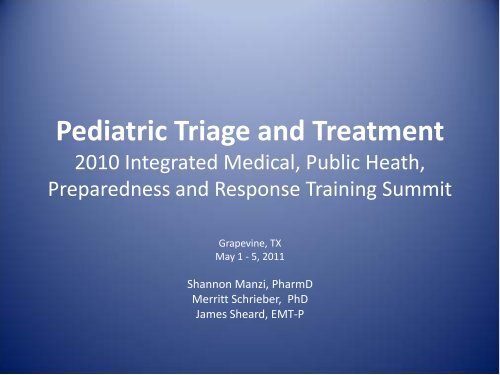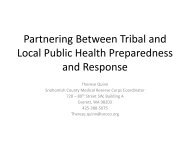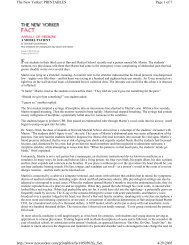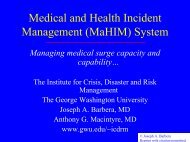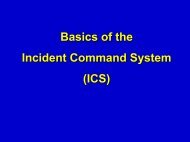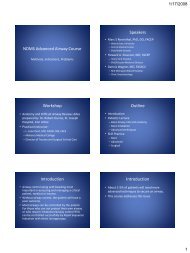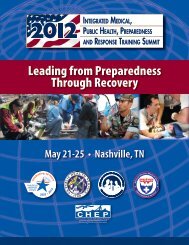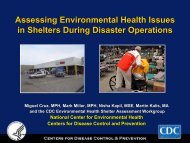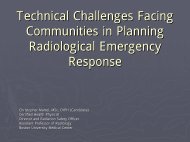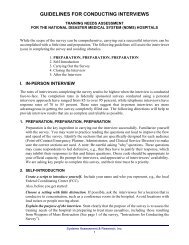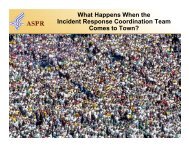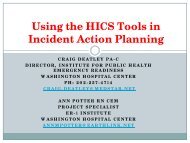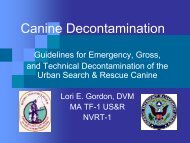Pediatric Triage and Treatment - The 2012 Integrated Medical ...
Pediatric Triage and Treatment - The 2012 Integrated Medical ...
Pediatric Triage and Treatment - The 2012 Integrated Medical ...
Create successful ePaper yourself
Turn your PDF publications into a flip-book with our unique Google optimized e-Paper software.
<strong>Pediatric</strong> <strong>Triage</strong> <strong>and</strong> <strong>Treatment</strong><br />
2010 <strong>Integrated</strong> <strong>Medical</strong>, Public Heath,<br />
Preparedness <strong>and</strong> Response Training Summit<br />
Grapevine, TX<br />
May 1 - 5, 2011<br />
Shannon Manzi, PharmD<br />
Merritt Schrieber, PhD<br />
James Sheard, EMT-P
Objectives of the Workshop<br />
• Describe appropriate use of a pediatric triage<br />
tool in disaster operations<br />
• List 3 commonly encountered pediatric<br />
disaster related illnesses or injuries<br />
• Create treatment plans based on the<br />
information presented
Course outline<br />
• Introduction (5 minutes)<br />
• <strong>Triage</strong> – Jim Sheard (15 minutes)<br />
• Mental Health – Merritt Schreiber (10<br />
minutes)<br />
• <strong>Treatment</strong> – Shannon Manzi (10 minutes)<br />
• Case presentations (60 minutes)<br />
• Questions/wrap up (10 minutes)
What is <strong>Triage</strong>?<br />
• “<strong>Triage</strong>” means “to sort”<br />
• Looks at medical needs <strong>and</strong> urgency<br />
of each individual patient<br />
• Sorting based on limited data<br />
acquisition<br />
• Also must consider resource<br />
availability
Why Should Responders Care About Good<br />
<strong>Triage</strong>?<br />
• Provides a way to draw organization<br />
out of chaos<br />
• Helps to get care to those who<br />
need it <strong>and</strong> will benefit from it the<br />
most<br />
• Helps in resource allocation<br />
• Provides an objective framework<br />
for stressful <strong>and</strong> emotional<br />
decisions
<strong>Triage</strong> is a dynamic process <strong>and</strong> is<br />
usually done more than once.
TYPES OF TRIAGE<br />
MCI/SURGE<br />
• MASS, SMART<br />
• SALT, SACCO<br />
• START/Jump START<br />
• Fixed set of evaluations<br />
• Life saving ABC’s<br />
DMAT TENT/F.M.S<br />
• Hospital Based<br />
• Flexible<br />
• Minor treatment
TRIAGE<br />
• Reguardless of what type…. Remember<br />
• Go back to your core skills think EMTs<br />
• How does your patient present<br />
• Bull Sh*t vs. “OH SH*T”<br />
• Oh my God vs. OH MY GOD<br />
• Sick vs. Not Sick
What does the <strong>Triage</strong> Officer Do?<br />
• Determines the priority of the patient by performing an<br />
Initial Basic Assessment<br />
• <strong>Treatment</strong> to stabilize life threatening problems in the<br />
ABC's that can quickly be corrected<br />
– Open Airway<br />
– Direct pressure or tourniquet to control bleeding<br />
– Minor care – Rx refill<br />
• Oh by the way “welcome to Walmart”<br />
– Security<br />
– Information<br />
– Press<br />
– Anything <strong>and</strong> everything else – Gate keeper
Primary <strong>Triage</strong><br />
• Goal: to sort patients based on probable<br />
needs for immediate care. Also to<br />
recognize futility.<br />
• Pearls:<br />
– Do the greatest good……..<br />
– <strong>Medical</strong> needs outstrip available resources<br />
– Additional resources will become available<br />
with time ( Thank God for LOG)<br />
– Which conditions will benefit the most from<br />
the expenditure of limited resources
Secondary <strong>Triage</strong><br />
• Goal: to best match patients’ current <strong>and</strong><br />
anticipated needs with available resources.<br />
• Incorporates:<br />
– A reassessment of physiology<br />
– An assessment of physical injuries<br />
– Initial treatment <strong>and</strong> assessment of patient<br />
response<br />
– Further knowledge of resource availability
Secondary <strong>Triage</strong> Tools<br />
• <strong>The</strong>re is no widely recognized tool in the<br />
US that addresses secondary MCI triage.<br />
• California “<strong>Medical</strong> Disaster Response”<br />
course’s SAVE tool (Secondary Assessment<br />
of Victim Endpoint)<br />
• Many EMS systems use local trauma<br />
center triage criteria.
Secondary <strong>Triage</strong>
Tertiary Disaster <strong>Triage</strong><br />
• Goal: to optimize individual outcome<br />
• Incorporates:<br />
– Sophisticated assessment <strong>and</strong><br />
treatment<br />
– Further assessment of available<br />
medical resources<br />
– Determination of best venue for<br />
definitive care
<strong>The</strong> Best Tool?<br />
It’s likely that no existing MCI<br />
triage tool is suitable for use for all<br />
types of incidents.
<strong>The</strong> GOALS<br />
• Flexible enough to use on adults & children of<br />
all ages<br />
• Reflects unique aspects of pediatric physiology<br />
• Use on ages 1-8 years<br />
• Can accomplish within 30 seconds
Primary Disaster <strong>Triage</strong><br />
• One of the most commonly used systems<br />
is the START/ JumpSTART tool.<br />
• Other tools exist but are less oriented to<br />
mass casualties than triaging smaller<br />
numbers of (adult) trauma patients.
START<br />
• Utilizes the same four triage<br />
categories<br />
• Used for Primary <strong>Triage</strong><br />
• www.start-triage.com
<strong>Triage</strong> Coding<br />
Priority <strong>Treatment</strong> Color<br />
Immediate 1 Red<br />
Urgent 2 Yellow<br />
Delayed 3 Green<br />
Dead 4 Black
START: Step 1<br />
<strong>Triage</strong> officer announces that all patients<br />
that can walk should get up <strong>and</strong> walk to<br />
a designated area for eventual<br />
secondary triage.<br />
All ambulatory patients are initially<br />
tagged as Green.
START <strong>Triage</strong><br />
RESPIRATIONS<br />
NO<br />
YES<br />
Over 30/min<br />
Under 30/min<br />
PERFUSION<br />
Position Airway<br />
Immediate<br />
Cap refill<br />
> 2 sec<br />
Cap refill<br />
< 2 sec.<br />
NO<br />
Dead or<br />
Expectant<br />
YES<br />
Immediate<br />
Control<br />
Bleeding<br />
Immediate<br />
Failure to follow<br />
simple comm<strong>and</strong>s<br />
MENTAL<br />
STATUS<br />
Can follow<br />
simple comm<strong>and</strong>s<br />
Immediate<br />
Delayed
Mnemonic<br />
R<br />
P<br />
M<br />
30<br />
2<br />
Can do
Protecting Children In Disasters<br />
• Children spend 70 to 80 % of their time away<br />
from home.<br />
• Soft targets<br />
– Multiple attacks in the past<br />
• Dunblame, UK. (1996)<br />
• Columbine, USA. (1999)<br />
• Beslan, Russia. (2004)<br />
• Lancaster County, Pa.(2006)
Why children are different<br />
• Anatomical<br />
– Pliable skeleton, greater risk for multiple internal<br />
organ injuries after blunt trauma.<br />
– Large head to body ratio, more likely to sustain<br />
traumatic brain injuries.
Why children are different<br />
• Developmental<br />
– Immature motor skills, may not be able to flee.<br />
– Immature cognitive skills, may not underst<strong>and</strong> the<br />
danger.<br />
• May run toward hazard.<br />
• Less cooperative may “melt down” think Stop <strong>and</strong> Shop
Why children are different<br />
• Physiological<br />
– Vital signs vary with age, making assessment difficult.<br />
– Faster respiratory rates <strong>and</strong> breathing zone closer to the<br />
ground.<br />
– Thinner skin, less protection <strong>and</strong> faster absorption of toxic<br />
chemicals.<br />
– Less fluid reserves even small amounts of fluid loss can<br />
mean big problems.
JumpSTART <strong>Pediatric</strong> MCI <strong>Triage</strong><br />
• Developed by Lou Romig MD, FAAP, FACEP<br />
• www.jumpstarttriage.com<br />
• Now in widespread use throughout the US <strong>and</strong><br />
Canada<br />
• Recognized by the US National Disaster <strong>Medical</strong><br />
System<br />
• Being taught in Japan, Germany, Switzerl<strong>and</strong>,<br />
the Dominican Republic, Africa, Polynesia
JumpSTART <strong>Pediatric</strong> MCI <strong>Triage</strong><br />
• <strong>The</strong> physiologic parameters used in START<br />
are not suitable for all ages of children<br />
– Walking<br />
– Respiratory death vs. cardiac death<br />
• Apneic child more likely to have primary<br />
respiratory problem<br />
• Respiratory rates<br />
– Cap refill may not adequately reflect<br />
hemodynamic status<br />
• Perfusion may be maintained for a short time<br />
– Mental status assessment<br />
• Obeying comm<strong>and</strong>s may not be good way to gauge<br />
mental status
How to Use JumpStart<br />
• Direct all ambulatory patients to designated<br />
GREEN area for triage<br />
• If the child is carried to GREEN area assess<br />
first<br />
• Begin assessment of non-ambulatory patients
What age?
Key Points about <strong>Triage</strong><br />
• Anything that can help organize the<br />
response is a good thing<br />
• MCI triage is different than daily triage,<br />
in both field <strong>and</strong> F.M.S settings<br />
• <strong>Triage</strong> should be done with the head,<br />
not the heart<br />
• This includes children!
Key Points about <strong>Triage</strong><br />
<strong>Triage</strong> will never be logistically,<br />
intellectually, or emotionally easy…<br />
but we must be prepared to do it using<br />
the best of our knowledge <strong>and</strong> abilities.
Psychological Impact<br />
Providing emotional support to both patients <strong>and</strong> fellow rescuers will<br />
minimize the impact <strong>and</strong> lessen the long term impact Critical Incident<br />
Stress<br />
• Patients<br />
– Feelings of loss may be<br />
over whelming, even if<br />
uninjured<br />
– Loss of friends/family<br />
– Loss of Property<br />
– Survivor Syndrome<br />
• Rescuers<br />
– Stress from<br />
environment<br />
– Pain/suffering<br />
– Loss of life<br />
– Devastation<br />
– Insufficient help or<br />
equipment
<strong>Treatment</strong> Principles<br />
• Working differential<br />
• Reliance on physical exam, limited imaging<br />
<strong>and</strong> laboratory testing<br />
• Limited formulary – being creative with what<br />
you have, underst<strong>and</strong> patient/family<br />
limitations <strong>and</strong> capability
<strong>The</strong> pediatric treatment area –<br />
when you are lucky
<strong>The</strong> Pharmacy – when you are lucky
<strong>The</strong> pediatric treatment area –<br />
reality
<strong>The</strong> Pharmacy – reality
Disclaimer - FDA non-approved uses<br />
• Nearly 70% of the treatments we use every<br />
day in children as st<strong>and</strong>ard of care are not<br />
approved by the FDA. This presentation will<br />
inevitably touch upon non-labeled uses for<br />
therapies that will be discussed. If you would<br />
like a notation of the off-label indications,<br />
please contact me after the meeting. Thank<br />
you.
Pharmacist responsibilities<br />
• Roles of the pharmacist in a disaster<br />
– Drug information<br />
– Dispensing <strong>and</strong> patient counseling<br />
– Medication reconciliation<br />
– Inventory <strong>and</strong> controlled substance management<br />
– Drug security <strong>and</strong> environmental control<br />
– Interface with community pharmacies, hospitals,<br />
etc<br />
– Interface with RxResponse, EPAP, etc
Disaster medicine<br />
• Most disaster pharmacy operations will need<br />
to support three types of dispensing:<br />
– medication orders for the treatment of patients<br />
undergoing immediate care<br />
– prescriptions for patients seen <strong>and</strong> discharged<br />
– team member prescriptions
EMR <strong>and</strong> MARs<br />
• In shelter care situations, a medication<br />
administration record (MAR) will need to be created,<br />
either electronically or on paper for documentation<br />
of medication administration by the care provider at<br />
the bedside. Daily reconciliation of the MAR will<br />
need to be performed by pharmacy for accuracy <strong>and</strong><br />
anticipation of what medications will be needed for<br />
the next day. Refills of medications need to be on a<br />
scheduled time frame (i.e. q24 hour pharmacy<br />
deliveries). Additionally a mechanism for refilling<br />
PRN medications <strong>and</strong> missing medications must be<br />
established.
<strong>Pediatric</strong> Disaster Pharmacy<br />
Concepts<br />
• Cache contents – not all pedi friendly<br />
• Resupply issues<br />
• <strong>Pediatric</strong> dosing<br />
– Math<br />
– Kinetics<br />
– Dosage forms<br />
• Medication error prevention, QI
It is all about the weight<br />
1 amp ≠1 dose<br />
• Weight based calculations<br />
– kg vs. lbs<br />
– BSA<br />
– Use of dosing tape, dosing cards<br />
• Use of dosing tapes, dosing cards<br />
– Minimize math at the bedside<br />
– St<strong>and</strong>ard doses, st<strong>and</strong>ard concentrations<br />
• <strong>Pediatric</strong> drug references for reconstitution,<br />
dilutions, infusion times
Routes of administration<br />
• IV<br />
• IO<br />
• IM<br />
• Oral<br />
• Nebulization<br />
• Subcutaneous<br />
• Sublingual<br />
• Buccal<br />
• Intranasal<br />
• Rectal<br />
• NG/Gtube/Jtube<br />
• ETT<br />
• Topical<br />
• Other (epidural, wound<br />
catheter, etc)
<strong>Pediatric</strong> Pharmacokinetic<br />
Principles<br />
• Intramuscular & Subcutaneous& topical absorption<br />
– reduced absorption in preterm infants<br />
– lower regional blood flow <strong>and</strong> reservoir mass<br />
– IM more effective in low perfusions states than SC<br />
– Stratum corneum underdeveloped, toxicity more likely<br />
• Intravenous & Intraosseous absorption<br />
– Peripheral vs. central access<br />
– Scalp, umbilical, h<strong>and</strong> <strong>and</strong> foot vein cannulation<br />
• Oral absorption <strong>and</strong> bioavailability<br />
– pH-dependent passive diffusion<br />
• gastric pH<br />
– motility of the stomach & small intestine<br />
• gastric emptying time<br />
• gastrointestinal perfusion
Manipulation of dosage forms<br />
• Modifying adult dosage forms (bristojets), creating a suspension<br />
from tablets/injection with published recipes<br />
• Cutting tablets <strong>and</strong> suppositories to an appropriate dose<br />
• Serial dilutions of an injectable medication to obtain a measurable<br />
dose for a newborn or infant. Must avoid excessive free water (i.e.<br />
dilution in D5W or < 0.45% NaCl).<br />
• Using suspensions for rectal dosing when a patient cannot take<br />
anything by mouth<br />
– Dilute 1:1 with tap water (sorbitol will induce explusion)<br />
– Often used for anti-epileptic medications<br />
• Using injectable form enterally<br />
– Dexamethasone, benzodiazepines, ondansetron
Example Calculations<br />
• 2 year old with vomiting <strong>and</strong> diarrhea for 3 days.<br />
Appears lethargic <strong>and</strong> minimally responsive. IStat<br />
glucose is 40. Order is given for “Dextrose 0.5<br />
grams/kg IV now”<br />
• You have D50W, D25W <strong>and</strong> D10W available <strong>and</strong> the<br />
patient weighs 13 kg<br />
• What volume of each concentration do you need?
Calculations<br />
Answer<br />
• D50W = 500 mg/mL<br />
• D25W = 250 mg/mL<br />
• D10W = 100 mg/mL<br />
<strong>The</strong>refore:<br />
• D50W = 1 mL/kg x 13 kg = 13 mL<br />
• D25W = 2 mL/kg x 13 kg = 26 mL<br />
• D10W = 5 mL/kg x 13 kg = 65 mL
Commonly encountered pediatric<br />
illnesses post-disaster<br />
• Allergic reactions/Anaphylaxis<br />
• Asthma/Status Asthmaticus<br />
• Bronchiolitis<br />
• Croup<br />
• Gastroenteritis<br />
• New onset diabetes/DKA<br />
• Overdose/toxic exposure<br />
• Emotional disorder, acute<br />
• Seizures/Status Epilepticus<br />
• Sepsis/meningitis<br />
• Trauma-related
Asthma/Status Asthmaticus<br />
• MDIs vs nebulizer<br />
– Use spacer<br />
– Does not require electricity or compressed<br />
gas/O 2<br />
– Is equally effective, if not superior<br />
• Homemade spacers<br />
– 500 mL plastic bottle<br />
Arch Dis Child 2000;82:495-498
Chronic <strong>Pediatric</strong> Conditions to<br />
consider<br />
• Asthma<br />
• Bleeding disorders<br />
• Complex care children<br />
• Cystic fibrosis<br />
• Diabetes<br />
• Mood stabilization/ADHD<br />
• End-stage renal disease<br />
• Oncologic processes/fever & neutropenia<br />
• Transplant recipients<br />
• HIV/AIDS
Medication reconciliation<br />
• Important for all, particularly important in a<br />
shelter mission<br />
• Accurate retrieval of information has been<br />
shown to be best accomplished by a<br />
pharmacist or highly trained pharmacy<br />
technician<br />
• Substitution <strong>and</strong> dose/frequency<br />
modifications are inevitable
<strong>The</strong> (Dreaded) Med List….<br />
Remeron (mirtazapine) 15 mg PG bedtime<br />
Fosamax (alendronate) tablet 70 mg PG<br />
qWednesday<br />
Klonopin (clonazepam) 0.5 mg PG BID<br />
Klonopin (clonazepam) 1 mg PG bedtime<br />
Zantac (ranitidine) 150 mg PG BID<br />
Prilosec (omeprazole) 40 mg PG BID<br />
Lasix (furosemide) 40 mg PG daily<br />
Keppra (levetiracetam) 1500 mg PG BID<br />
Actigall (ursodiol) 165 mg PG BID<br />
Lovenox (enoxaparin) 100 mg/mL injection 33 mg<br />
SC BID<br />
Mycostatin (Nystatin) ointment, apply topically TID<br />
Micatin (miconazole) powder, apply topically QID<br />
Ocean spray (sodium chloride 0.65%) nasal drops,<br />
Instill 1 drop each nare BID<br />
Aldactone (spironolactone) 100 mg PG BID<br />
Baclofen (baclofen) 10 mg PG TID<br />
Allegra (fexofenadine) 30 mg PG BID<br />
Elavil (amitriptyline) 30 mg PG bedtime<br />
Culturelle (Lactobacillus GG) 2 caps PG TID<br />
Neurontin (gabapentin) capsule 150 mg PG<br />
TID<br />
Tums EX (calcium carbonate) 1125 mg PG<br />
BID<br />
Bactroban (muprocin) ointment, apply<br />
topically BID<br />
Domeboro Packet 1 pkt topically BID<br />
Prednisone (prednisone) tablet 25 mg PG<br />
daily<br />
Potassium chloride 40 mEq PG BID (Put in<br />
end of feed)<br />
Bactrim DS<br />
(sulfamethoxazole/trimethoprim)<br />
tablet 160 mg (trimethoprim) PG daily<br />
Vitamin D (ergocalciferol) 2000 units PG<br />
daily<br />
Flonase (fluticasone) nasal spray 2 sprays<br />
daily<br />
Ventolin (albuterol) MDI with spacer 2 puffs<br />
inhaled TID PRN wheezing
Medication Errors in <strong>Pediatric</strong>s<br />
• Literature vacuum of disaster medicine related errors<br />
• ED/outpatient medication errors may correlate to<br />
some extent, closest surrogate available at this time<br />
– <strong>Pediatric</strong> ED related medication errors rate 1.6% in ED<br />
orders, 2.2% outpatient prescriptions defined as wrong<br />
dose (Peds Emerg Care 2008)<br />
– <strong>Pediatric</strong> ED trauma/resuscitation orders, error rate of 15%<br />
prior to implementation of st<strong>and</strong>ard ordering, 6% post<br />
implementation (Peds Emer Care 2008)
Medication Errors <strong>and</strong> Adverse<br />
Reactions in <strong>Pediatric</strong>s<br />
– Return visits for Adverse Drug Reactions (may or may not<br />
involve an error) are estimated at 0.5% of all ED visits (2009<br />
<strong>Pediatric</strong>s)<br />
• Antibiotics most common class<br />
– Outpatient ADR rates have been estimated as high as 16%<br />
of all prescriptions<br />
– Pilots of error rates in adults boarding in EDs have shown<br />
upwards of 17% missed doses of scheduled meds <strong>and</strong> a 3%<br />
preventable adverse reaction rate (Ann Emerg Med 2009)
Medication errors in DMAT/FMS<br />
operations???<br />
• Completely unknown<br />
• Requires study
Future enhancements (suggested)<br />
• EMR upgrades to support<br />
– <strong>Pediatric</strong> dosing<br />
– Ongoing MAR documentation<br />
– Medication reconciliation<br />
• <strong>Pediatric</strong> dosing cards, references<br />
• <strong>Pediatric</strong> cache (both meds <strong>and</strong> equipment)<br />
• Medication error/adverse drug event rates<br />
monitoring during/post disaster operations<br />
• Include disaster training core content for<br />
pharmacists in pharmacy schools
Case presentation<br />
• Rules of the game<br />
• Team work<br />
• Assignments
Wrap up & Questions<br />
Shannon Manzi, PharmD<br />
MA-1 DMAT<br />
Department of Pharmacy<br />
300 Longwood Ave<br />
Children’s Hospital Boston<br />
Boston, MA 02115<br />
Email: shannon.manzi@childrens.harvard.edu<br />
Phone: 617-355-2837<br />
Merritt Schreiber, Ph.D.,<br />
Senior Manager,<br />
Psychological Programs<br />
Associate Research Psychologist<br />
Center for Public Health <strong>and</strong> Disasters<br />
UCLA Center for the Health Sciences<br />
Email: mschreiber@mednet.ucla.edu<br />
Phone: 714-394-5577<br />
James Sheard, EMT-P<br />
MA-1 DMAT<br />
Hingham Fire Department<br />
Hingham, MA<br />
Email: jsheard100@yahoo.com<br />
Phone: 781-267-9551


